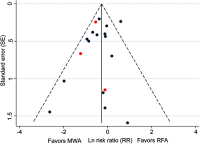Microwave ablation compared with radiofrequency ablation for treatment of hepatocellular carcinoma and liver metastases: a systematic review and meta-analysis
- PMID: 31496742
- PMCID: PMC6698169
- DOI: 10.2147/OTT.S204340
Microwave ablation compared with radiofrequency ablation for treatment of hepatocellular carcinoma and liver metastases: a systematic review and meta-analysis
Abstract
Purpose: Percutaneous ablation techniques, including microwave ablation (MWA) and radiofrequency ablation (RFA), have become important minimally invasive treatment options for liver cancer. This systematic review compared MWA with RFA for treatment of liver cancer.
Methods: The systematic review and meta-analysis followed the Preferred Reporting Items for Systematic Reviews and Meta-Analyses (PRISMA) guidelines. A systematic search of MEDLINE, EMBASE, and Cochrane Central Register of Controlled Trials was conducted for randomized and observational studies published from 2006 onwards. A random-effects model was used for meta-analyses and local tumor progression (LTP), technique efficacy, overall survival (OS), disease-free survival (DFS), intrahepatic de novo lesions (IDL), extrahepatic metastases (EHM), length of stay (LOS), and complications were analyzed. Subgroup and sensitivity analyses were also conducted.
Results: Of 1379 studies identified, 28 randomized and observational studies met inclusion criteria. The main analysis demonstrated that LTP was significantly reduced by 30% with MWA versus RFA (RR=0.70; P=0.02) (all studies) and by 45% with MWA versus RFA (RR=0.55; P=0.007) (randomized studies only). There were no significant differences between MWA and RFA for other efficacy and safety outcomes. Higher frequency (2450 MHz) and larger tumor size (≥2.5 cm) are amongst variables that may be associated with improved outcomes for MWA. Sensitivity analyses were generally congruent with the main results.
Conclusion: MWA is at least as safe and effective as RFA for treating liver cancer and demonstrated significantly reduced LTP rates. Future studies should assess time and costs associated with these two treatment modalities.
Keywords: hepatocellular carcinoma; liver cancer; meta-analysis; microwave ablation; radiofrequency ablation.
Conflict of interest statement
SG, JWC, MBG, and JFA are employees of Ethicon, Inc. (manufacturer of Neuwave microwave ablation instrumentation). RAQ, NCF, BS, and GWJW are employees of Cornerstone Research Group, who were sponsored to perform this study by Ethicon, Inc. MBG reports stocks and stock options from Johnson & Johnson during the conduct of the study. The authors report no other conflicts of interest in this work.
Figures





Similar articles
-
Microwave ablation compared with radiofrequency ablation for the treatment of liver cancer: a systematic review and meta-analysis.Radiol Oncol. 2021 Jun 25;55(3):247-258. doi: 10.2478/raon-2021-0030. Radiol Oncol. 2021. PMID: 34167181 Free PMC article.
-
Systematic review and meta-analysis of local ablative therapies for resectable colorectal liver metastases.Eur J Surg Oncol. 2020 May;46(5):772-781. doi: 10.1016/j.ejso.2019.12.003. Epub 2019 Dec 4. Eur J Surg Oncol. 2020. PMID: 31862133
-
Small single perivascular hepatocellular carcinoma: comparisons of radiofrequency ablation and microwave ablation by using propensity score analysis.Eur Radiol. 2021 Jul;31(7):4764-4773. doi: 10.1007/s00330-020-07571-5. Epub 2021 Jan 5. Eur Radiol. 2021. PMID: 33399908 Free PMC article.
-
Percutaneous thermal ablation for primary hepatocellular carcinoma: A systematic review and meta-analysis.J Gastroenterol Hepatol. 2016 Feb;31(2):294-301. doi: 10.1111/jgh.13028. J Gastroenterol Hepatol. 2016. PMID: 26114968
-
Comparison of microwave ablation and radiofrequency ablation for hepatocellular carcinoma: a systematic review and meta-analysis.Int J Hyperthermia. 2019;36(1):264-272. doi: 10.1080/02656736.2018.1562571. Epub 2019 Jan 24. Int J Hyperthermia. 2019. PMID: 30676100
Cited by
-
Percutaneous microwave ablation applications for liver tumors: recommendations for COVID-19 patients.Heliyon. 2021 Mar 6;7(3):e06454. doi: 10.1016/j.heliyon.2021.e06454. eCollection 2021 Mar. Heliyon. 2021. PMID: 33748501 Free PMC article. Review.
-
Radiofrequency ablation versus microwave ablation for early stage hepatocellular carcinoma: A PRISMA-compliant systematic review and meta-analysis.Medicine (Baltimore). 2020 Oct 23;99(43):e22703. doi: 10.1097/MD.0000000000022703. Medicine (Baltimore). 2020. PMID: 33120763 Free PMC article.
-
Long-term results of liver thermal ablation in patients with hepatocellular carcinoma and colorectal cancer liver metastasis regarding spatial features and tumor-specific variables.Diagn Interv Radiol. 2024 May 13;30(3):183-192. doi: 10.4274/dir.2023.221986. Epub 2023 Mar 20. Diagn Interv Radiol. 2024. PMID: 36994643 Free PMC article.
-
The Role of Ablative Techniques in the Management of Hepatocellular Carcinoma: Indications and Outcomes.Biomedicines. 2023 Mar 31;11(4):1062. doi: 10.3390/biomedicines11041062. Biomedicines. 2023. PMID: 37189680 Free PMC article. Review.
-
Microwave Ablation of Recurrent Hepatocellular Carcinoma after Curative Surgical Resection.J Clin Med. 2023 Mar 29;12(7):2560. doi: 10.3390/jcm12072560. J Clin Med. 2023. PMID: 37048644 Free PMC article.
References
-
- World Health Organization. Cancer fact sheet. [Updated February 2018] Available from: http://www.who.int/mediacentre/factsheets/fs297/en/. Accessed April3, 2018.
-
- Verslype C, Rosmorduc O, Rougier P, Group EGW. Hepatocellular carcinoma: ESMO-ESDO clinical practice guidelines for diagnosis, treatment and follow-up. Ann Oncol. 2012;23(Suppl 7):vii41–vii48. - PubMed
LinkOut - more resources
Full Text Sources
Miscellaneous

